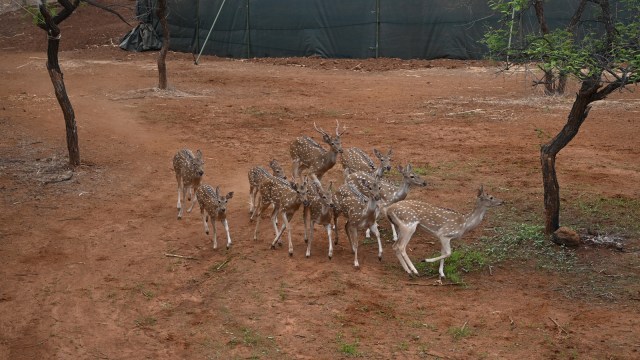In Gujarat, the Forest Department has initiated a significant conservation effort aimed at enhancing the long-term survival of Asiatic lions by translocating prey species to the Barda Wildlife Sanctuary. This move is crucial as Barda is becoming a secondary habitat for these lions, supplementing their primary habitat in Gir Forest.
Translocation of Spotted Deer and Sambar
To bolster the prey population for Asiatic lions in Barda Wildlife Sanctuary, the Gujarat Forest Department has begun translocating spotted deer (cheetal) and sambars from Gir Forest, located approximately 100 kilometers away. This effort is part of a broader strategy to improve the ecosystem balance and support the natural dispersal of lions into Barda.
- Method Used: The translocation involves capturing animals using the Boma technique, where animals are directed into enclosures using funnel-like fencing.
- Initial Batch: Recently, 23 spotted deer were captured and transported to Barda Wildlife Sanctuary.
Importance for Conservation
The initiative is expected to have several conservation benefits:
- Ecological Balance: Augmenting the prey base in Barda supports the establishment of a sustainable ecosystem for Asiatic lions.
- Historical Context: Lions historically inhabited Barda until their disappearance in 1879; recent efforts aim to restore this natural habitat.
- Recent Developments: Since 2023, lions have begun naturally recolonizing Barda, highlighting its potential as a lion habitat.
Future Plans and Implications
- Continued Efforts: The translocation efforts will continue to build a robust prey population in Barda, ensuring a stable environment for lions.
- Ecological Assessment: The Forest Department monitors the impact of translocation on Barda’s ecosystem to ensure sustainable conservation practices.
Multiple Choice Questions (MCQs) with Answers:
- What is the primary objective of translocating spotted deer and sambars to Barda Wildlife Sanctuary?
- A) Increase tourism revenue
- B) Restore historical lion habitats
- C) Introduce new species
- D) Reduce human-wildlife conflict
- Answer: B) Restore historical lion habitats
- Which technique is used by Gujarat Forest Department for capturing animals for translocation?
- A) Tranquilizer darts
- B) Boma technique
- C) Aerial surveillance
- D) Remote sensing
- Answer: B) Boma technique
- When did Asiatic lions start recolonizing Barda Wildlife Sanctuary naturally?
- A) 2005
- B) 2010
- C) 2023
- D) 2015
- Answer: C) 2023
- What is the current status of Asiatic lions’ primary habitat?
- A) Expanding rapidly
- B) Experiencing decline
- C) Stable
- D) Limited to Gujarat
- Answer: D) Limited to Gujarat
- Which animals are primarily targeted for translocation to Barda to support the lion population?
- A) Tigers
- B) Leopards
- C) Spotted deer and sambars
- D) Elephants
- Answer: C) Spotted deer and sambars
